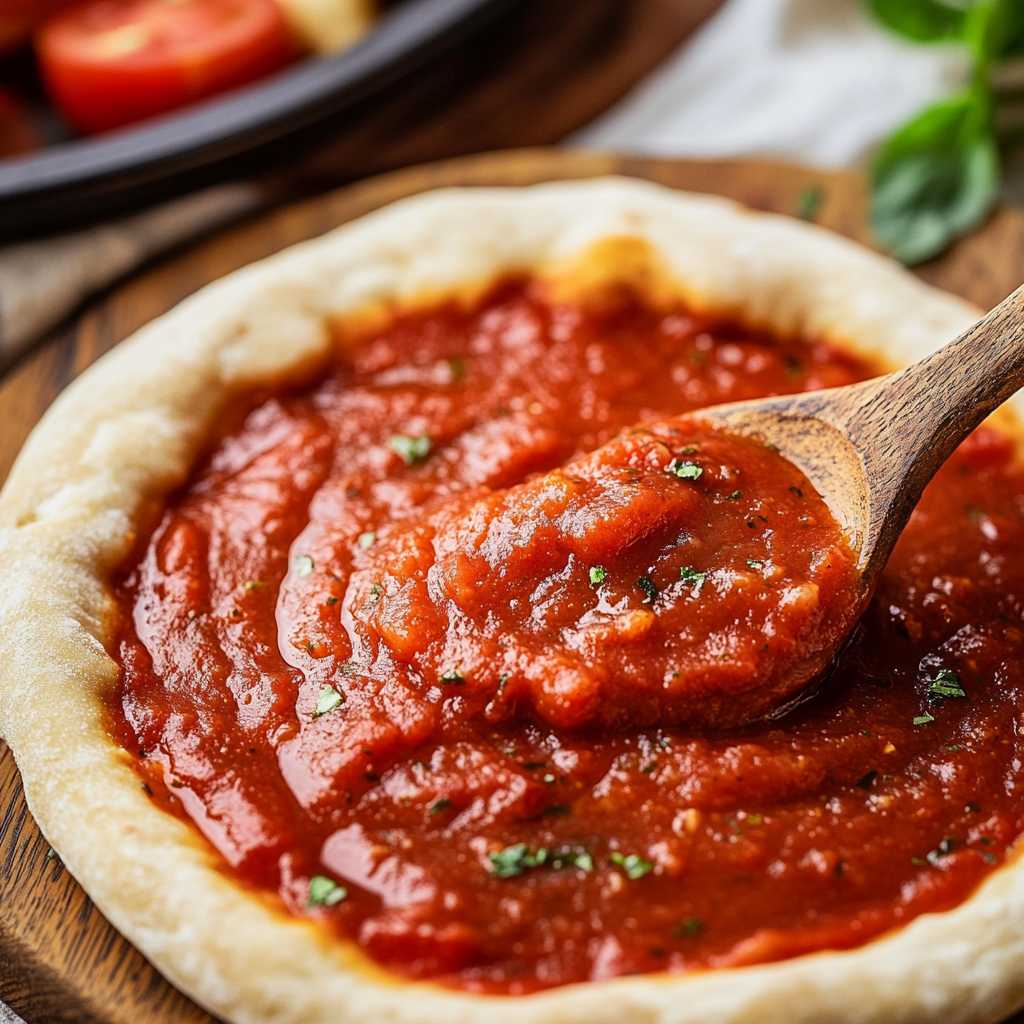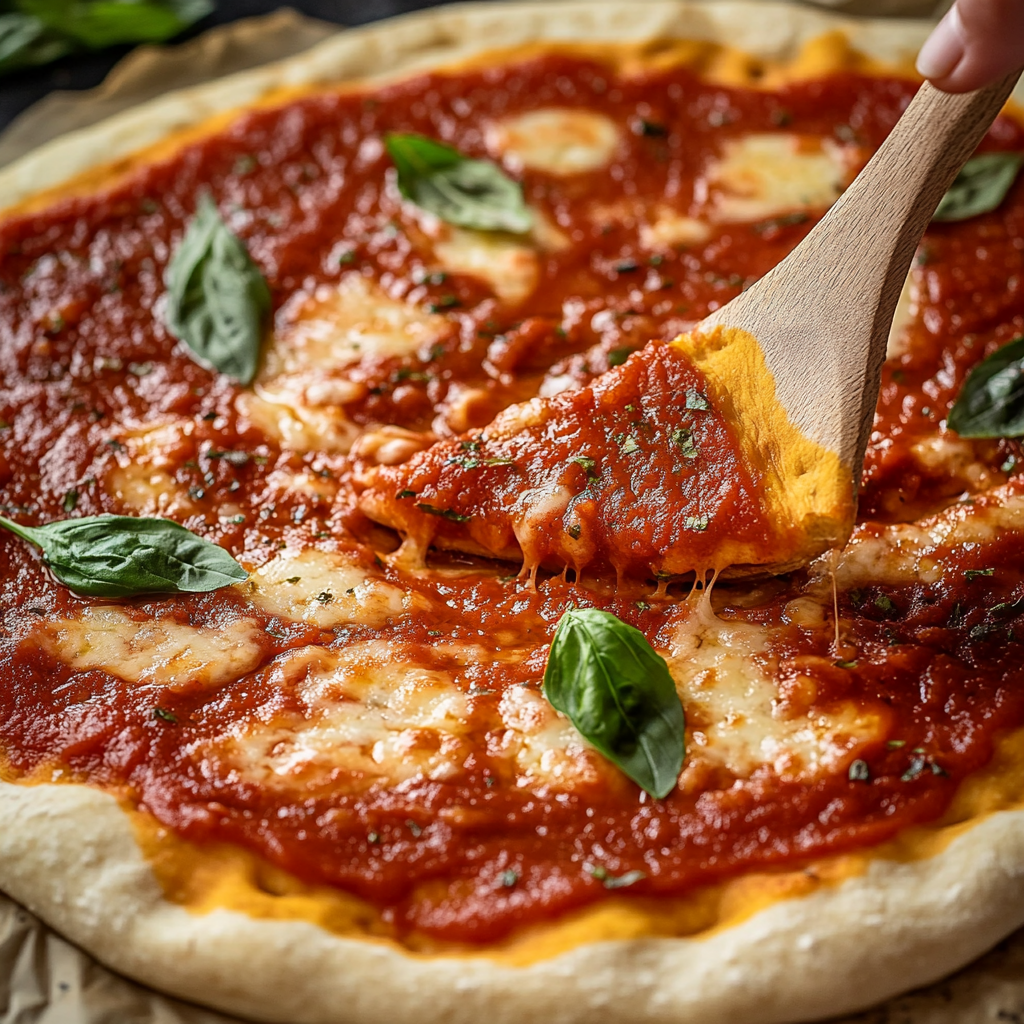Introduction
Have you ever wondered what makes a pizza truly unforgettable? The secret lies in the sauce! A vibrant and flavorful pizza sauce can elevate your favorite dish from ordinary to extraordinary. Imagine spreading a rich, tangy tomato blend over a warm crust and watching it bubble as it bakes—this aroma will entice anyone who walks into the kitchen.
This homemade pizza sauce isn’t just easy to make; it’s also packed with fresh flavors that will take your pizzas to new heights. Perfect for family gatherings or casual dinners with friends, this recipe promises an amazing culinary experience. Get ready to impress your loved ones with every slice!
Why You’ll Love This Pizza Sauce
Rich Flavor Profile: This pizza sauce bursts with robust flavors thanks to fresh tomatoes, fragrant herbs, and spices. Each bite becomes an explosion of taste that complements any toppings you choose.
Quick and Easy Preparation: Making this pizza sauce is a breeze! In just about 30 minutes, you can whip up enough sauce for multiple pizzas. Say goodbye to store-bought versions filled with preservatives.
Versatile Use: Not just for pizzas! This versatile sauce can enhance pasta dishes, serve as a dip for breadsticks, or even be used as a base for casseroles.
Healthy Ingredients: With fresh tomatoes and herbs at its core, this sauce is a healthier alternative to many commercial options. Enjoy authentic flavors without compromising on health.
Ingredients
Here’s what you’ll need to make this delicious dish:
- Canned Whole Tomatoes: Opt for high-quality whole peeled tomatoes for the best flavor; San Marzano tomatoes are recommended.
- Fresh Garlic: Fresh garlic cloves provide a bold flavor compared to pre-minced alternatives; use about 3-4 cloves.
- Dried Oregano: This herb adds an authentic Italian touch; choose organic if possible for better quality.
- Dried Basil: Dried basil complements the tomato’s sweetness perfectly; avoid using too much as it can overpower the dish.
- Olive Oil: Use extra virgin olive oil for its fruity notes that enhance the overall flavor of the sauce.
For the Sauce:
- Sugar: A pinch of sugar balances the acidity of the tomatoes; adjust according to your preference.
The full ingredients list, including measurements, is provided in the recipe card directly below.
How to Make Pizza Sauce
Follow these simple steps to prepare this delicious dish:
Prepare Your Ingredients: Start by gathering all your ingredients on a clean countertop. Drain the canned tomatoes and set them aside.
Blend Tomatoes: In a blender or food processor, add the canned whole tomatoes along with their juice. Pulse until smooth but still slightly chunky.
Sauté Garlic: Heat olive oil in a medium saucepan over medium heat. Add minced garlic and sauté until fragrant but not browned, about 1-2 minutes.
Add Spices and Herbs: Stir in dried oregano and dried basil into the saucepan with garlic. Cook for another minute to release their aromas.
Combine Everything Together: Pour in the blended tomatoes along with sugar and salt. Bring everything to a simmer and reduce heat; let it cook uncovered for about 20 minutes until thickened.
Cool and Store: Once cooked, allow the sauce to cool before using or storing in an airtight container in the fridge for up to one week.
Tips and Tricks
Here are some helpful tips to ensure the best results for your dish:
Use High-Quality Tomatoes: Choosing good quality canned tomatoes makes all the difference in flavor; look for those packed in juice rather than puree.
Adjust Seasoning as Needed: Always taste your sauce before serving; feel free to adjust salt or add more sugar if it tastes too acidic.
Add Fresh Herbs if Possible: If you have access to fresh basil or oregano, consider adding them towards the end of cooking for an extra burst of flavor.
Store Properly for Future Use: If making ahead of time, store leftover pizza sauce in ice cube trays; once frozen solid, transfer cubes into freezer bags for future convenience.
Experiment with Spices: Feel free to customize your spice mix by trying crushed red pepper flakes or Italian seasoning based on your preference!
Mistakes to avoid
Overcooking the Sauce
One of the most common mistakes when making pizza sauce is overcooking it. While cooking helps to blend flavors, excessive heat can lead to a burnt taste and loss of freshness. Simmer your sauce gently for about 20 to 30 minutes. This allows the ingredients to meld while preserving the vibrant tomato flavor. Avoid leaving it on the heat for too long, as this will change its texture and taste significantly.
Neglecting Fresh Ingredients
Using canned or dried ingredients can lead to a dull pizza sauce. Fresh tomatoes, herbs, and garlic elevate the flavor profile immensely. Whenever possible, opt for ripe Roma tomatoes and fresh basil to create an authentic taste. If fresh ingredients are unavailable, choose high-quality canned tomatoes as a substitute. The quality of your ingredients directly impacts the overall flavor of your pizza sauce.
Skipping Seasoning Steps
Seasoning is crucial in making a delicious pizza sauce. Many cooks forget to taste as they go, which can result in bland sauce. Always add salt and pepper gradually, tasting frequently until you achieve the desired flavor balance. Herbs like oregano and thyme should also be included early in the cooking process to allow their flavors to infuse properly into the sauce.
Not Allowing Time for Flavors to Develop
Rushing through the preparation can lead to a lackluster sauce. It’s essential to allow your pizza sauce time to simmer so that all the flavors can develop fully. Aim for at least 20 minutes of simmering time after you’ve combined all your ingredients. This step enhances depth and richness, resulting in a more robust and satisfying final product that will elevate your pizza experience.
Ignoring Texture Consistency
The texture of your pizza sauce plays a significant role in how it adheres to your crust and complements your toppings. A sauce that’s too watery can make your pizza soggy, while one that’s too thick may not spread easily. Aim for a smooth, slightly chunky consistency by blending some ingredients but leaving others intact for texture. Adjust with water or crushed tomatoes as needed until you reach your preferred consistency.
Forgetting About Storage Options
Many people overlook proper storage methods for leftover pizza sauce, which can lead to spoilage or loss of flavor. Always cool your sauce completely before transferring it into an airtight container. Store it in the refrigerator if you plan to use it within a week or freeze it for longer storage, ideally up to three months. Proper storage preserves its quality so you can enjoy homemade pizza anytime without compromising on taste.
Using Too Much Sugar
While some recipes call for sugar in pizza sauce, using too much can overpower natural tomato flavors and make your sauce overly sweet. Instead of adding sugar immediately, try balancing acidity with fresh herbs or spices first. If necessary, add only a pinch of sugar at the end of cooking after tasting so you don’t mask the authentic tomato essence that makes great pizza sauce shine.
Serving Suggestions
This Pizza sauce is versatile and pairs wonderfully with various dishes. You can use it as a base for traditional pizza, spreading a generous layer on your dough before adding toppings like cheese, pepperoni, and vegetables. For a quick snack, try it as a dipping sauce for breadsticks or mozzarella sticks. The tangy flavor enhances the taste of these appetizers beautifully.
You can also incorporate this Pizza sauce into pasta dishes. Simply toss cooked pasta with the sauce for a quick meal that feels gourmet. For an Italian twist, add some sautéed vegetables or grilled chicken to elevate the dish further. This sauce also works great in casseroles; layering it between ingredients adds moisture and flavor depth.
For a fun twist, consider using this Pizza sauce in flatbreads or calzones. Spread the sauce inside the dough along with your favorite fillings for a delicious treat that everyone will love. Additionally, it’s perfect for topping baked potatoes or drizzling over roasted vegetables, providing a zesty kick to your side dishes.
Another excellent way to enjoy this Pizza sauce is in sandwiches and wraps. Spread it onto your bread or tortillas before filling them with meats, cheeses, and fresh veggies. It adds a delightful burst of flavor that takes your lunch to the next level. Lastly, use it as a marinade for grilled meats to infuse them with taste before cooking.

FAQs
What is the best way to store leftover Pizza sauce?
To store leftover Pizza sauce properly, place it in an airtight container and refrigerate it immediately after use. It will last up to one week in the fridge. For longer storage, consider freezing it in ice cube trays or freezer-safe bags. This allows you to use just the right amount when needed without wasting any.
Can I make Pizza sauce ahead of time?
Yes, making Pizza sauce ahead of time is a great idea! You can prepare it days in advance and store it in the refrigerator until you’re ready to use it. This allows the flavors to meld beautifully over time, enhancing its taste when used on pizzas or other dishes.
Is homemade Pizza sauce healthier than store-bought?
Homemade Pizza sauce often contains fewer preservatives and additives compared to store-bought versions. By making your own, you control the ingredients and customize flavors according to your preferences. This can lead to healthier meal options while still enjoying delicious pizza nights with family and friends.
Can I adjust the spice level of my Pizza sauce?
Absolutely! You can easily adjust the spice level of your Pizza sauce by adding more or fewer spices according to your taste preferences. For heat lovers, incorporating crushed red pepper flakes or cayenne pepper can enhance the flavor significantly. Conversely, if you prefer milder sauces, reduce these spicy elements accordingly.
Conclusion
In summary, this Pizza sauce serves as an essential ingredient that elevates many dishes beyond just pizza. Its versatility allows for creative uses from dipping sauces to pasta enhancements and marinades for meats. Whether you’re preparing a simple meal at home or hosting friends for dinner, having delicious homemade pizza sauce on hand makes everything tastier.
By learning how to store and prepare this rich tomato-based sauce ahead of time, you enhance convenience during mealtime preparation while ensuring quality flavors are always available at your fingertips. Experimenting with different spice levels lets you tailor this recipe perfectly for every palate. Enjoy exploring all the ways this wonderful Pizza sauce can complement your culinary adventures!

Homemade Pizza Sauce
- Total Time: 30 minutes
- Yield: About 2 cups (8 servings) 1x
Description
Elevate your pizza nights with this rich and flavorful homemade pizza sauce. Crafted from high-quality canned tomatoes, fragrant garlic, and a blend of aromatic herbs, this sauce brings a burst of vibrant taste to every slice. In just 30 minutes, you can whip up a batch that’s free from preservatives, making it a healthier alternative to store-bought options. This versatile sauce not only enhances pizza but also works beautifully in pasta dishes or as a delightful dip for appetizers. Whether you’re hosting friends or enjoying a cozy family dinner, impress everyone with this easy-to-make sauce that promises an unforgettable culinary experience.
Ingredients
- 1 can (28 oz) whole peeled tomatoes (preferably San Marzano)
- 3–4 cloves fresh garlic, minced
- 1 tsp dried oregano
- 1 tsp dried basil
- 2 tbsp extra virgin olive oil
- 1 tsp sugar (to balance acidity)
- Salt to taste
Instructions
- Gather all ingredients and drain the canned tomatoes.
- In a blender, pulse the canned tomatoes until smooth but slightly chunky.
- Heat olive oil in a saucepan over medium heat; sauté minced garlic until fragrant (about 1-2 minutes).
- Stir in dried oregano and basil; cook for another minute.
- Add blended tomatoes, sugar, and salt; bring to a simmer.
- Cook uncovered for about 20 minutes until the sauce thickens, then cool before use.
- Prep Time: 10 minutes
- Cook Time: 20 minutes
- Category: Sauce
- Method: Simmering
- Cuisine: Italian
Nutrition
- Serving Size: 1/4 cup (60g)
- Calories: 50
- Sugar: 4g
- Sodium: 220mg
- Fat: 2g
- Saturated Fat: 0g
- Unsaturated Fat: 2g
- Trans Fat: 0g
- Carbohydrates: 10g
- Fiber: 2g
- Protein: 2g
- Cholesterol: 0mg
Keywords: - For added flavor, consider using fresh herbs towards the end of cooking. - Adjust seasoning to taste—add more sugar if the sauce is too acidic. - Freeze any leftover sauce in ice cube trays for convenient future use.


